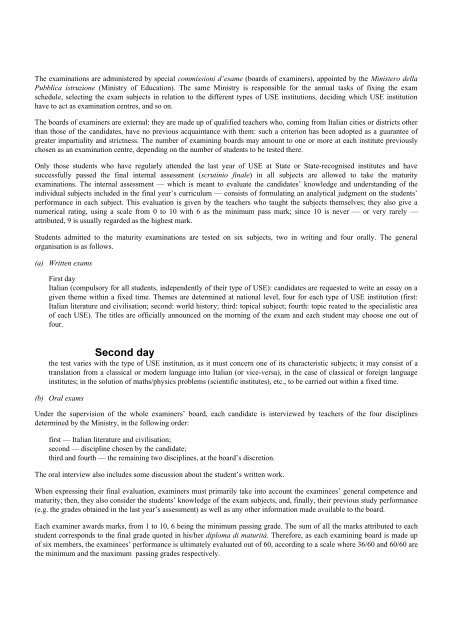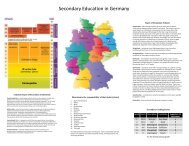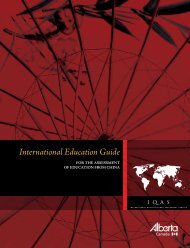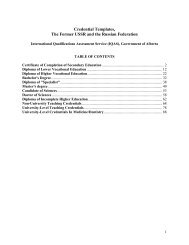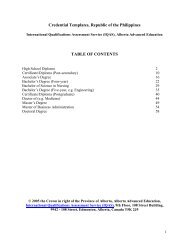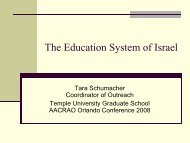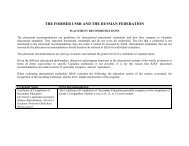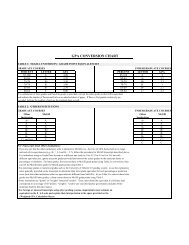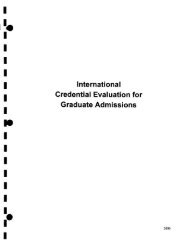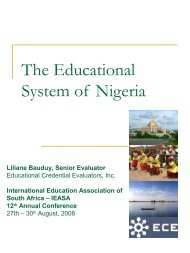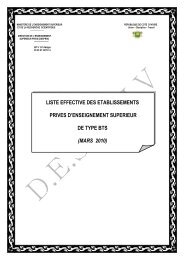NARIC guide on Higher Education Systems in the European Union
NARIC guide on Higher Education Systems in the European Union
NARIC guide on Higher Education Systems in the European Union
You also want an ePaper? Increase the reach of your titles
YUMPU automatically turns print PDFs into web optimized ePapers that Google loves.
The exam<strong>in</strong>ati<strong>on</strong>s are adm<strong>in</strong>istered by special commissi<strong>on</strong>i d’esame (boards of exam<strong>in</strong>ers), appo<strong>in</strong>ted by <strong>the</strong> M<strong>in</strong>istero della<br />
Pubblica istruzi<strong>on</strong>e (M<strong>in</strong>istry of Educati<strong>on</strong>). The same M<strong>in</strong>istry is resp<strong>on</strong>sible for <strong>the</strong> annual tasks of fix<strong>in</strong>g <strong>the</strong> exam<br />
schedule, select<strong>in</strong>g <strong>the</strong> exam subjects <strong>in</strong> relati<strong>on</strong> to <strong>the</strong> different types of USE <strong>in</strong>stituti<strong>on</strong>s, decid<strong>in</strong>g which USE <strong>in</strong>stituti<strong>on</strong><br />
have to act as exam<strong>in</strong>ati<strong>on</strong> centres, and so <strong>on</strong>.<br />
The boards of exam<strong>in</strong>ers are external: <strong>the</strong>y are made up of qualified teachers who, com<strong>in</strong>g from Italian cities or districts o<strong>the</strong>r<br />
than those of <strong>the</strong> candidates, have no previous acqua<strong>in</strong>tance with <strong>the</strong>m: such a criteri<strong>on</strong> has been adopted as a guarantee of<br />
greater impartiality and strictness. The number of exam<strong>in</strong><strong>in</strong>g boards may amount to <strong>on</strong>e or more at each <strong>in</strong>stitute previously<br />
chosen as an exam<strong>in</strong>ati<strong>on</strong> centre, depend<strong>in</strong>g <strong>on</strong> <strong>the</strong> number of students to be tested <strong>the</strong>re.<br />
Only those students who have regularly attended <strong>the</strong> last year of USE at State or State-recognised <strong>in</strong>stitutes and have<br />
successfully passed <strong>the</strong> f<strong>in</strong>al <strong>in</strong>ternal assessment (scrut<strong>in</strong>io f<strong>in</strong>ale) <strong>in</strong> all subjects are allowed to take <strong>the</strong> maturity<br />
exam<strong>in</strong>ati<strong>on</strong>s. The <strong>in</strong>ternal assessment — which is meant to evaluate <strong>the</strong> candidates’ knowledge and understand<strong>in</strong>g of <strong>the</strong><br />
<strong>in</strong>dividual subjects <strong>in</strong>cluded <strong>in</strong> <strong>the</strong> f<strong>in</strong>al year’s curriculum — c<strong>on</strong>sists of formulat<strong>in</strong>g an analytical judgment <strong>on</strong> <strong>the</strong> students’<br />
performance <strong>in</strong> each subject. This evaluati<strong>on</strong> is given by <strong>the</strong> teachers who taught <strong>the</strong> subjects <strong>the</strong>mselves; <strong>the</strong>y also give a<br />
numerical rat<strong>in</strong>g, us<strong>in</strong>g a scale from 0 to 10 with 6 as <strong>the</strong> m<strong>in</strong>imum pass mark; s<strong>in</strong>ce 10 is never — or very rarely —<br />
attributed, 9 is usually regarded as <strong>the</strong> highest mark.<br />
Students admitted to <strong>the</strong> maturity exam<strong>in</strong>ati<strong>on</strong>s are tested <strong>on</strong> six subjects, two <strong>in</strong> writ<strong>in</strong>g and four orally. The general<br />
organisati<strong>on</strong> is as follows.<br />
(a) Written exams<br />
First day<br />
Italian (compulsory for all students, <strong>in</strong>dependently of <strong>the</strong>ir type of USE): candidates are requested to write an essay <strong>on</strong> a<br />
given <strong>the</strong>me with<strong>in</strong> a fixed time. Themes are determ<strong>in</strong>ed at nati<strong>on</strong>al level, four for each type of USE <strong>in</strong>stituti<strong>on</strong> (first:<br />
Italian literature and civilisati<strong>on</strong>; sec<strong>on</strong>d: world history; third: topical subject; fourth: topic reated to <strong>the</strong> specialistic area<br />
of each USE). The titles are officially announced <strong>on</strong> <strong>the</strong> morn<strong>in</strong>g of <strong>the</strong> exam and each student may choose <strong>on</strong>e out of<br />
four.<br />
<br />
<strong>the</strong> test varies with <strong>the</strong> type of USE <strong>in</strong>stituti<strong>on</strong>, as it must c<strong>on</strong>cern <strong>on</strong>e of its characteristic subjects; it may c<strong>on</strong>sist of a<br />
translati<strong>on</strong> from a classical or modern language <strong>in</strong>to Italian (or vice-versa), <strong>in</strong> <strong>the</strong> case of classical or foreign language<br />
<strong>in</strong>stitutes; <strong>in</strong> <strong>the</strong> soluti<strong>on</strong> of maths/physics problems (scientific <strong>in</strong>stitutes), etc., to be carried out with<strong>in</strong> a fixed time.<br />
(b) Oral exams<br />
Under <strong>the</strong> supervisi<strong>on</strong> of <strong>the</strong> whole exam<strong>in</strong>ers’ board, each candidate is <strong>in</strong>terviewed by teachers of <strong>the</strong> four discipl<strong>in</strong>es<br />
determ<strong>in</strong>ed by <strong>the</strong> M<strong>in</strong>istry, <strong>in</strong> <strong>the</strong> follow<strong>in</strong>g order:<br />
first — Italian literature and civilisati<strong>on</strong>;<br />
sec<strong>on</strong>d — discipl<strong>in</strong>e chosen by <strong>the</strong> candidate;<br />
third and fourth — <strong>the</strong> rema<strong>in</strong><strong>in</strong>g two discipl<strong>in</strong>es, at <strong>the</strong> board’s discreti<strong>on</strong>.<br />
The oral <strong>in</strong>terview also <strong>in</strong>cludes some discussi<strong>on</strong> about <strong>the</strong> student’s written work.<br />
When express<strong>in</strong>g <strong>the</strong>ir f<strong>in</strong>al evaluati<strong>on</strong>, exam<strong>in</strong>ers must primarily take <strong>in</strong>to account <strong>the</strong> exam<strong>in</strong>ees’ general competence and<br />
maturity; <strong>the</strong>n, <strong>the</strong>y also c<strong>on</strong>sider <strong>the</strong> students’ knowledge of <strong>the</strong> exam subjects, and, f<strong>in</strong>ally, <strong>the</strong>ir previous study performance<br />
(e.g. <strong>the</strong> grades obta<strong>in</strong>ed <strong>in</strong> <strong>the</strong> last year’s assessment) as well as any o<strong>the</strong>r <strong>in</strong>formati<strong>on</strong> made available to <strong>the</strong> board.<br />
Each exam<strong>in</strong>er awards marks, from 1 to 10, 6 be<strong>in</strong>g <strong>the</strong> m<strong>in</strong>imum pass<strong>in</strong>g grade. The sum of all <strong>the</strong> marks attributed to each<br />
student corresp<strong>on</strong>ds to <strong>the</strong> f<strong>in</strong>al grade quoted <strong>in</strong> his/her diploma di maturità. Therefore, as each exam<strong>in</strong><strong>in</strong>g board is made up<br />
of six members, <strong>the</strong> exam<strong>in</strong>ees’ performance is ultimately evaluated out of 60, accord<strong>in</strong>g to a scale where 36/60 and 60/60 are<br />
<strong>the</strong> m<strong>in</strong>imum and <strong>the</strong> maximum pass<strong>in</strong>g grades respectively.


